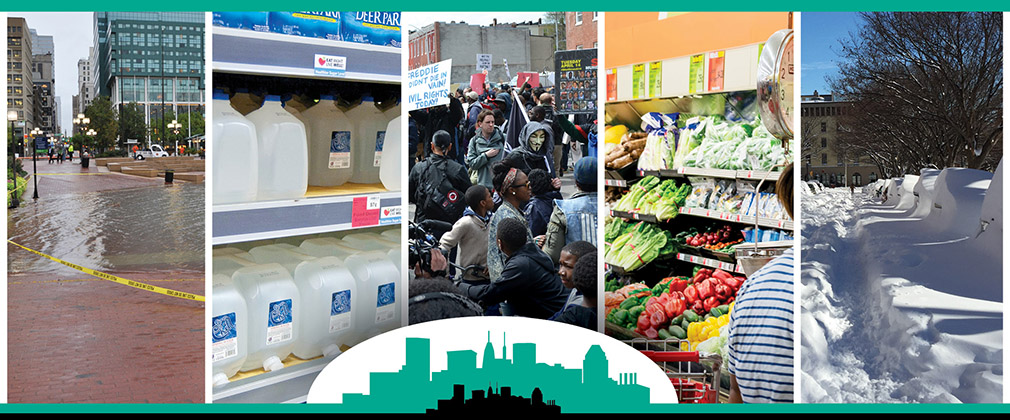New Report Offers Blueprint for Baltimore Food System Resilience
Aug 02, 2017
A new report published today identifies actions Baltimore City can take to protect food security in the event of a natural or human-made disaster. As cities across the country consider how to manage threats from climate change, the report’s findings highlight the importance of integrating food systems issues into disaster preparedness plans.
The 162-page report is the result of a collaboration by the Baltimore Office of Sustainability (BoS) and researchers at the Johns Hopkins Center for a Livable Future (CLF) in the Bloomberg School of Public Health’s Department of Environmental Health and Engineering. CLF researchers developed the report using diverse sources including geospatial mapping analysis and interviews with community members, local businesses, food assistance organizations, and government agencies. Recommendations from the report will be used to develop a Food System Resilience Plan for the city and update Baltimore’s Disaster Preparedness Plan (DP3) in 2017. These plans play a central role guiding the city’s emergency management and response efforts.
“Building food system resilience is about much more than just disaster preparedness. It requires actively confronting issues driving food insecurity in the here-and-now,” said Erin Biehl, lead author of the report and Senior Program Coordinator of CLF’s Food System Sustainability & Public Health Program. “One big takeaway from this report is that there are actions Baltimore can take that would both respond to current food access needs and enhance the city’s ability to adapt to threats like climate change.”
In their analysis, CLF researchers appraised the Baltimore food system’s current strengths and vulnerabilities, and assessed how 14 types of emergencies—such as storms, electrical outages, terrorist attacks, pandemics, economic crises, and civil unrest—could impact the city’s food supply. Researchers determined that unexpected shocks to the food system could result in decreased economic and physical access to food, problems with food safety and acceptability, disruptions to the food supply chain, labor shortages, communication failures, and issues with food storage and waste removal.
“In order to plan for disruptions to the food system, we need to understand how crises could impact each link in the supply chain from farm to food bank. Resilience frameworks are useful tools for taking all this into account,” said Sarah Buzogany, Food Access Planner for Baltimore City’s Food Policy Initiative. “The report will be a valuable resource for the city, and we are proud of all the work that’s come from our partnership with the Johns Hopkins Center for a Livable Future.”
The strengths of the Baltimore food system noted in the report include a diverse group of food assistance organizations, strong community networks, and local policies and initiatives working to address food and health disparities such as the Food Desert Retail Strategy. Key weaknesses involve high rates of food insecurity, public transportation challenges, and limited awareness of and resources for disaster preparedness among residents.
Stakeholders interviewed for the report described how an event like a severe winter storm could disrupt their capacity to supply food to others, or their ability to access food themselves. For example, weather-related school closures especially impact students who rely on free school breakfast and lunch programs. Those at most risk of losing access to safe and nutritious food during crises include people with low incomes, residents of food deserts, children, older adults, people with disabilities, people experiencing homelessness, and people with special dietary needs.
Researchers identified several steps that the city government, nonprofits, businesses, and individuals can take to enhance emergency response and food security throughout the city. Strategies recommended by the report focus on strengthening the local and regional food economy, building preparedness capacity among small-scale food businesses and nonprofits, designating critical food facilities in each neighborhood, and developing community food storage and communications plans.
The report also offers guidance for other cities on increasing resilience in their own local food systems. The authors emphasize that cities interested in incorporating food systems into their disaster preparedness plans can use the report to conduct their own studies or integrate food systems perspectives into preexisting initiatives or frameworks.
“Baltimore is one of the first cities in the country to assess and plan for resilience at all levels of the food system,” said Roni Neff, PhD, an assistant professor in the Bloomberg School’s Department of Environmental Health and Engineering who oversaw the study and directs CLF’s Food System Sustainability & Public Health Program. “This approach has a lot of potential to help drive the policy innovations that Baltimore and other cities need to protect residents’ access to safe, healthy, and affordable food for years to come.”
The Baltimore Food System Resilience Advisory Report was written by Erin Biehl and Roni Neff of the Johns Hopkins Center for a Livable Future, Sarah Buzogany and Alice Huang of the Baltimore Office of Sustainability, and Gwen Chodur of the Johns Hopkins Bloomberg School of Public Health. The report was produced with support from the CLF, the Johns Hopkins 21st Century Cities Initiative, and the Johns Hopkins Urban Health Institute.
 View Report
View Report